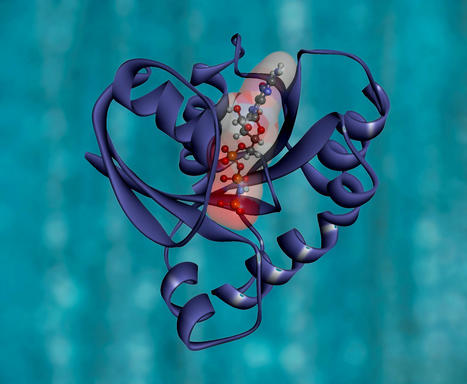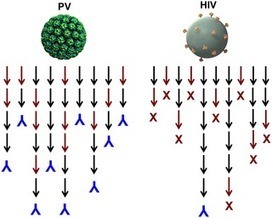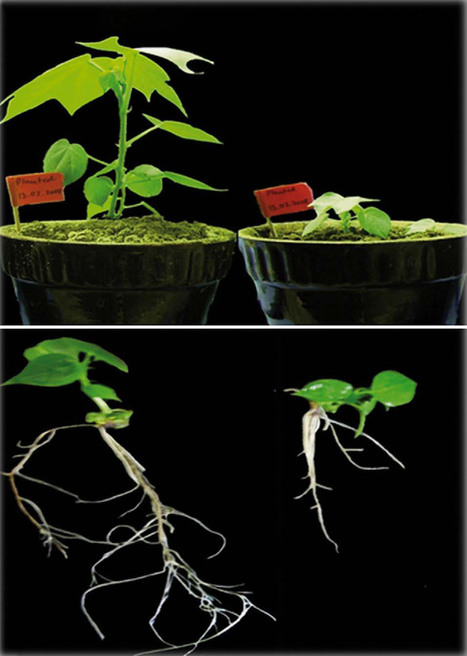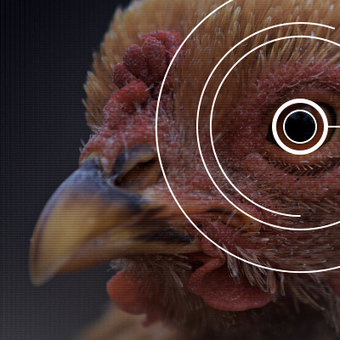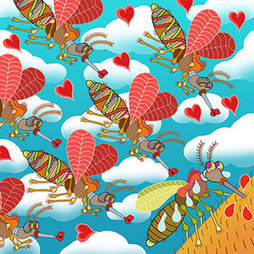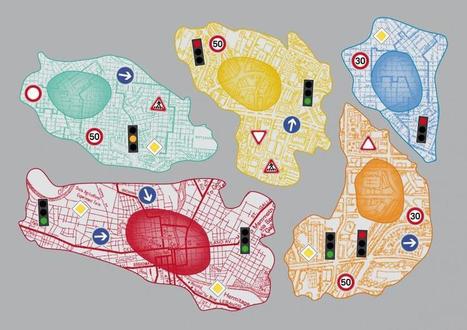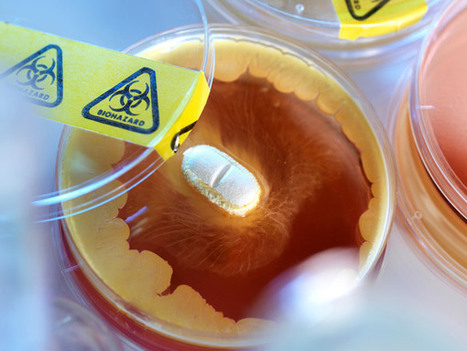 Your new post is loading...
 Your new post is loading...
Through synthetic biology, scientists can add novel functions to cells, such as the ability to produce new materials or detect and respond in specific ways to diseases. Though the applications are exciting, the process suffers from some inefficiencies—one of which Stanford University chemical engineer Xiaojing Gao is working to avoid.
Via Gerd Moe-Behrens
Chemical triggers that make plants defend themselves against insects could replace pesticides, causing less damage to the environment. New research... identifies five chemicals that trigger rice plants to fend off a common pest – the white-backed planthopper, Sogatella furcifera Pesticides are used around the world to control insects that destroy crops... One of the problems with many pesticides is that they kill indiscriminately. For rice plants, this means pesticides kill the natural enemies of one of their biggest pests, the white-backed planthopper... This pest... causes the plants to wilt and can damage the grains. It also transmits a virus disease... which stunts the plants’ growth and stops them from “heading,” which is when pollination occurs. Left untreated, many of the insects’ eggs would be eaten, but when pesticides are used these hatch, leading to even more insects on the plants. What’s more, in some areas as many as a third of the planthoppers are resistant to pesticides... “Therefore, developing safe and effective methods to control insect pests is highly desired”... Because of the problems of using pesticides, it’s vital to find new solutions to help protect rice plants from infestation. Plants have natural self-defense mechanisms that kick in when they are infested with pests like the planthopper. This defense mechanism can be switched on using chemicals that do not harm the environment and are not toxic to the insects or their natural enemies... Researchers... developed a new way of identifying these chemicals. Using a specially designed screening system, they determined to what extent different chemicals switched on the plants’ defense mechanism... The researchers used bioassays to show that these chemicals could trigger the plant defense mechanism and repel the white-backed planthopper. This suggests that these chemicals have the potential to be used in insect pest management... “This new approach to pest management could help protect the ecosystem while defending important crops against attack.” The next step for the research will be to explore how effective the chemicals are at boosting the plants’ defenses and controlling planthoppers in the field. https://www.elsevier.com/about/press-releases/research-and-journals/chemicals-that-make-plants-defend-themselves-could-replace-pesticides Original article: http://dx.doi.org/10.1016/j.bmcl.2015.10.041
Via Alexander J. Stein
Accessing information efficiently is vital for animals to make the optimal decisions, and it is particularly important when they are facing predators. Yet until now, very few quantitative conclusions have been drawn about the information dynamics in the interaction between animals due to the lack of appropriate theoretic measures. Here, we employ transfer entropy (TE), a new information-theoretic and model-free measure, to explore the information dynamics in the interaction between a predator and a prey fish. We conduct experiments in which a predator and a prey fish are confined in separate parts of an arena, but can communicate with each other visually and tactilely. TE is calculated on the pair’s coarse-grained state of the trajectories. We find that the prey’s TE is generally significantly bigger than the predator’s during trials, which indicates that the dominant information is transmitted from predator to prey. We then demonstrate that the direction of information flow is irrelevant to the parameters used in the coarse-grained procedures. We further calculate the prey’s TE at different distances between it and the predator. The resulted figure shows that there is a high plateau in the mid-range of the distance and that drops quickly at both the near and the far ends. This result reflects that there is a sensitive space zone where the prey is highly vigilant of the predator’s position. Information Dynamics in the Interaction between a Prey and a Predator Fish
Feng Hu, Li-Juan Nie and Shi-Jian Fu Entropy 2015, 17(10), 7230-7241; http://dx.doi.org/10.3390/e17107230 ;
Via Complexity Digest, Phillip Trotter
Growing nerve tissue and organs is a sci-fi dream. Moheb Costandi met the pioneering researcher who grew eyes and brain cells.
From molecules to physiology
A few years ago, I started looking online to fill in chapters of my family history that no one had ever spoken of.
In light of the Marine Strategy Framework Directive (MSFD) and the EU Thematic Strategy on the Sustainable Use of Natural Resources, environmental biotechnology could make significant contributions in the exploitation of marine resources and addressing key marine environmental problems. In this paper 14 propositions are presented focusing on (i) the contamination of the marine environment, and more particularly how to optimize the use of biotechnology-related tools and strategies for predicting and monitoring contamination and developing mitigation measures; (ii) the exploitation of the marine biological and genetic resources to progress with the sustainable, eco-compatible use of the maritime space (issues are very diversified and include, for example, waste treatment and recycling, anti-biofouling agents; bio-plastics); (iii) environmental/marine biotechnology as a driver for a sustainable economic growth. http://dx.doi.org/10.1016/j.nbt.2014.03.007
Via Alexander J. Stein
An international collaboration... has figured out how to make a longer cotton fiber... could potentially have a multi-billion-dollar impact on the global cotton industry and help cotton farmers fend off increasing competition from synthetic fibers... "This technology allows improvement of fiber quality in upland cotton, which is widely grown everywhere," said Alan Pepper, an associate professor in the Texas A&M Department of Biology... "This will increase the competitiveness of natural cotton fibers versus synthetic fibers, which have been snagging an increasing amount of the market share every year." The overwhelming majority of cotton harvested in the U.S. and worldwide is upland cotton, or Gossypium hirsutum, with more than 6.5 million acres planted in 2012 in Texas alone... A higher-end cotton called Gossypium barbadense is more desirable because of greater fiber length and strength but is late-maturing, low-yielding and more difficult to grow because it requires dry climates with significant irrigation and is less resistant to pathogens and pests. "For a long time cotton breeders have been trying to develop upland cotton with the fiber qualities ofbarbadense cotton... Globally, everybody's trying to do it. Economically, it's a huge deal, because every millimeter you add to fiber length adds that much to the price of cotton when the farmer sells it." The researchers' method increased the length of the fiber by at least 5 millimeters, or 17 percent, compared to the control plants in their experiment... The cotton plants developed in the project technically are genetically modified organisms (GMOs)... "What we're doing is a little different," Pepper said. "We're not actually adding in a gene from another species. Rather, we're knocking down the effect of one of the genes that's already in the plant... This was pure basic science, seeking to understand the biological function of a gene... And sure enough, the phytochrome 'knock-down' plants had all these phenotypic changes associated with it [phytochrome], and one of them was longer fiber." The discovery was especially important to Ibrokhim Abdurakhmonov, the lead author of the study who received his master's degree in plant breeding from Texas A&M in 2001 and is now a professor in his native Uzbekistan. The landlocked agricultural nation that borders Afghanistan historically has relied heavily on cotton... Uzbekistan currently accounts for around 10 percent of world cotton fiber exports. "Sustainability and biosecurity of cotton production is pivotal for the Uzbekistan economy because agriculture accounts for 24-to-28 percent of the country's gross domestic product... The increased value of longer and stronger lint, at 10 cents per pound, would be at least $100 per acre more income from the lint for each new cultivar using this technology. New markets for longer, finer, stronger and more uniform cotton lint fiber, as well as early maturity and increased yield potential could further increase estimated economic value. Our anticipation of possible improvement of resistance to abiotic stresses via phytochrome RNA interference further adds to its commercial potential." ... Press release: http://www.science.tamu.edu/articles/1157/ Original article: http://dx.doi.org/10.1038/ncomms4062
Via Alexander J. Stein
USC scientists have identified a new regulator for the intracellular trafficking of proteins between the endoplasmic reticulum and Golgi apparatus, which is a crucial process for maintaining homeostasis and prevention of human disease.
Miniature "human brains" have been grown in a lab in a feat scientists hope will transform the understanding of neurological disorders.
Dolphins call each other by name using unique signature whistles, a study suggests.
Sequencing DNA from individual cells is changing the way that researchers think of humans as a whole.
|
Scientists are exploring a mysterious pattern, found in birds’ eyes, boxes of marbles and other surprising places, that is neither regular nor random.
The students in Anthony James’s basement insectary at the University of California, Irvine, knew they’d broken the laws of evolution when they looked at the mosquitoes’ eyes.
By rights, the bugs, born from fathers with fluorescent red eyes and mothers with normal ones, should have come out only about half red. Instead, as they counted them, first a few and then by the hundreds, they found 99 percent had glowing eyes.
More important than the eye color is that James’s mosquitoes also carry genes that stop the malaria parasite from growing. If these insects were ever released in the wild, their “selfish” genetic cargo would spread inexorably through mosquito populations, and potentially stop the transmission of malaria.
The technology, called a “gene drive,” was built using the gene-editing technology known as CRISPR and is being reported by James, a specialist in mosquito biology, and a half dozen colleagues today in the Proceedings of the National Academy of Sciences.
A functioning gene drive in mosquitoes has been anticipated for more than a decade by public health organizations as a revolutionary novel way to fight malaria. Now that it’s a reality, however, the work raises questions over whether the technology is safe enough to ever be released into the wild.
“This is a major advance because it shows that gene drives will likely be effective in mosquitoes,” says Kevin Esvelt, a gene drive researcher at Harvard University’s Wyss Institute. “Technology is no longer the limitation.”
Starting last summer, Esvelt and other scientists began warning that gene drives were about to jump from theory to reality (see “Protect Society from Our Inventions, Says Genome Editing Scientists”) and needed more attention by regulators and the public. The National Academy of Sciences is studying the science and ethics of the technology and plans to release recommendations next year on “responsible conduct” by scientists and companies.
Gene drives are just the latest example of the fantastic power of CRISPR editing to alter the DNA of living things, which has already set off a debate over the possibility that gene editing could be used to generate designer human babies (see “Engineering the Perfect Baby”). But Henry Greely, a law professor and bioethics specialist at Stanford, says environmental uses are more worrisome than a few modified people. “The possibility of remaking the biosphere is enormously significant, and a lot closer to realization,” he says.
Malaria is caused when a mosquito bite transmits plasmodium, a single-celled parasite. It’s treatable, yet every year, 670,000 people die from malaria, the majority of them young children in sub-Saharan Africa.
James says his mosquitoes are the culmination of decades of mostly obscure, unheralded work by a few insect specialists toward constructing a genetic solution to malaria. It finally became possible this year when scientists in the laboratory of Ethan Bier, a fly biologist at the University of California, San Diego, who is a coauthor of the paper, finally used CRISPR to perfect a molecular “motor” that could allow the anti-malaria genes to spread.
The mosquitoes have two important genetic additions. One is genes that manufacture antibodies whenever a female mosquito has a “blood meal.” Those antibodies bind to the parasite’s surface and halt its development. Yet normally, such an engineered mosquito would pass the genes only to exactly half its offspring, since there’s a 50 percent chance any chunk of DNA would come from its mate. And since the new genes probably don’t help a mosquito much, they’d quickly peter out in the wild.
That’s where CRISPR comes in. In a gene drive, components of the CRISPR system are added such that any normal gene gets edited and the genetic cargo is added to it as well. In James’s lab, practically all the mosquitoes ended up with the genetic addition, a result Esvelt calls “astounding.”
What worries Esvelt is that, in his opinion, the California researchers haven’t used strict enough safety measures. He says locked doors and closed cages aren’t enough. He wants them to install a genetic “reversal drive” so the change can be undone, if necessary. “An accidental release would be a disaster with potentially devastating consequences for public trust in science and especially gene-drive interventions,” he says. “No gene-drive intervention must ever be released without popular support.”
James says the experiment was safe since the mosquitoes are kept behind a series of locked, card-entry doors and because they aren’t native to California. If any escaped, they wouldn’t be able to reproduce.
In fact, the whole point of a gene drive is to release it into the wild, a concept that has long been accepted, at least in theory, by public health organizations including the Gates Foundation. Now that they’re actually possible, however, alarming news headlines have compared the technology to “the next weapon of mass destruction” and even raised the specter of insect terrorism, such as mosquitoes that kill people with a toxin.
Gene-drive terrorism is probably nonsense, at least for now. That’s because even if insect weapons were possible, in practice it’s unlikely a terrorist organization would invest millions in an advanced genetic-engineering program. “I have been thinking quite a bit about bad things you could do with it, and we haven’t come up with anything that would succeed,” says Bier. “There are so many bad things you could do that are easier.”
Instead, Bier and James say they are convinced that engineered mosquitoes should be released as soon as possible, something they hope to do if they can find a community affected by malaria that will agree to it. “Imagine we could design a mosquito that would magically cure cancer,” says Bier. “Well, the fear of getting malaria is the same fear we have of getting cancer. In my opinion the benefits outweigh the risks, and we should move forward as aggressively as we can.”
Via Gerd Moe-Behrens
"The Biopython project is a mature open source international collaboration of volunteer developers, providing Python libraries for a wide range of bioinformatics problems."
Our bodies are a genetic patchwork, possessing variation from cell to cell. Is that a good thing?
cientists have made an amplifier to boost biological signals, using DNA and harmless E. coli bacteria. Conventional amplifiers, such as those that are combined with loudspeakers to boost the volume of electric guitars and other instruments, are used to increase the amplitude of electrical signals. Now scientists from Imperial College London have used the same engineering principles to create a biological amplifier, by re-coding the DNA in the harmless gut bacteria Escherichia coli bacteria (E. coli).
Via Gerd Moe-Behrens
Cells regulate the uptake of nutrients and messenger cargos and their transport within the cell. This process is known as endocytosis and membrane traffic. Different cargos dock onto substrate specific receptors on the cell membrane. Special proteins such as kinases, GTPases and coats, activate specific entry routes and trigger the uptake of the receptors into the cell. For their uptake, the receptors and docked cargos become enclosed by the cell membrane. In the next steps, the membrane invaginates and becomes constricted. The resulting vesicle is guided via several distinct stations, cellular organelles, to its final destination in the cell. For her study, Dr. Prisca Liberali, senior scientist in the team of Professor Lucas Pelkmans, sequentially switched off 1200 human genes. Using automated high-throughput light microscopy and computer vision, she could monitor and compare 13 distinct transport paths involving distinct receptors and cellular organelles. Precise quantifications of thousands of single cells identified the genes required for the different transport routes. Surprisingly, sets of transport routes are co-regulated and coordinated in specific ways by different programs of regulatory control. Subsequently, Dr. Liberali calculated the hierarchical order within the genetic network and thereby identified the regulatory topology of cellular transport. "The transport into the cell and within the cells proceeds analogously to the cargo transport within a city" describes the scientist. "Like in a city, the traffic on the routes within a cell and their intersections is tightly regulated by traffic lights and signs to guide the cargo flow." Thanks to this unique quantitative map, the fine regulatory details of transport paths and processes within a cells could be mapped for the first time. Particularly the genes that encode for these traffic lights and switches are often de-regulated in disease. With this map, it is now possible to predict how this leads to traffic jams in the cells, causing the disease phenotype. Alternatively, since many drugs have been developed to target these traffic lights and switches, the map can be used to come up with possible drug combinations to target unwanted traffic, such as viruses, to the waste disposal system of the cell.
Via Dr. Stefan Gruenwald, burkesquires
"Superbug" bacterial infections that are resistant to common antibiotics are increasing at an alarming rate. But traditional antibiotics aren't the only way to battle dangerous germs. Biomedical scientists are investigating new additions to their arsenal.
Robert S. Engelmore Memorial Award Lecture - Cancer results from finite genomic mutations that biotechnology can easily list, and that we can mostly understand and reason about in terms of the underlying biochemistry.
In a major scientific first, a team of developmental biologists has built a functional mouse heart from human tissues. The results herald a future where specific patches of heart muscle – or even the whole organ – could be grown for transplantation.
Nearly 80% of bumblebees imported from Europe carry pathogens that pose a threat to UK native honeybees and bumblebees, say scientists.
|



 Your new post is loading...
Your new post is loading...
